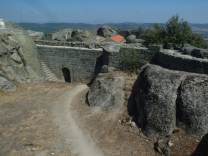No video yet

Monsanto (Idanha-a-Nova)
Monsanto is a village and a former civil parish in the municipality of Idanha-a-Nova, Portugal. In 2013, the parish merged into the new parish Monsanto e Idanha-a-Velha. It covered an area of 131.76 km² and had 828 inhabitants (June 30, 2011). It was the principal town of the concelho between 1174 and the beginning of the 19th century, and the county seat in the period of 1758-1853. In recent decades, Monsanto has become popularly known as "the most Portuguese village of Portugal" in a class of twelve classified historic villages in Portugal. The emblem of Portugal, the Silver Rooster (Galo de Prata), designed by Abel Pereira da Silva, can be seen atop the Clock Tower or Lucano.
The mountain Monsanto (Latin: Mons Sanctus) rises abruptly to the East of the Idanha-a-Nova up to 758 meters above sea level.
The earliest traces of man is from Early Stone Age at the time of the ice-ages. Later, Romans settled at the base of the mountain. Also traces from Visigoth in the early Middle Ages and even earlier Arab presence has been found in the area.
In the 12th century, King Afonso I of Portugal conquered Monsanto from the Moors as part of the Christian Reconquista. In 1165, he granted the custody of the city to a knights' order of the church, first to the Order of Knights Templar, and later to the Order of Santiago. The city was given to the military orders to maintain the reconquested city on Christian hands, and Grand Master the Order of Knights Templar, Gualdim Pais, was manager of the building of the fortress. Later, King Sancho I of Portugal reconstructed and repopulated it after the wars with the Leonese. Unfortunately, the...







